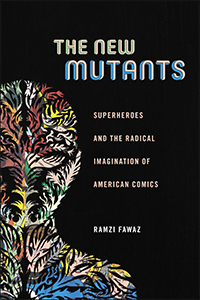From Comic Book Cosmopolitics to Alternative Genetic Futures

In his new book The New Mutants: Superheroes and the Radical Imagination of American Comics, comics scholar Ramzi Fawaz chronicles the history of the relationship between superhero comics and American radical identity politics. Through a series of close readings of iconic superhero storylines such as the Justice League of America, The Fantastic Four of the sixties and the X-Men sagas of Chris Claremont, Fawaz uncovers the ways in which the superhero team in particular has functioned as a powerful tool for imagining new ways of belonging in American culture as it developed during the Cold War era. He describes how the Justice League identified as citizens of the world, although from a very American perspective, and how the work of Stan Lee and Jack Kirby in the Fantastic Four expanded this trend into what Fawaz calls a “comic book cosmopolitics” through their interaction with and inclusion of mutants and alien species in an “inhuman anthropology” that lead to a radically inclusive definition of the limits of the human.
In the superhero comics of the 1960’s , Fawaz argues, solidarity, belonging and the idea of the “human family” (as we encounter it in the Declaration of Human Rights) was grounded not upon assimilation and identification, but on difference as a defining trait of humanity. He goes on to uncover the various (and often overlooked) ways in which the characters of the Fantastic Four demonstrated this difference as belonging not only in terms of race and nationality, but also, to an astounding degree, in terms of a destabilizing of gender identities and sexuality. In his reading of the X-Men, Fawaz develops this observation by identifying the X-Men’s self-perception as a “queer mutanity”, a “fluxability” of gender and identity for which their genetic mutations are both metaphor and catalyst.
Genetic mutations and scientific progress plays a large part in the evolution of the superhero genre and Fawaz’ reading of it. However, it is only towards the very end of the book that he suggests that we might read these stories in a way that is useful for thinking about human evolution not just as a metaphor for the evolution of human society and its varying degrees of inclusion and exclusion, but as something that might happen. In the final chapter, “Lost in the Badlands”, Fawaz shows how the rise of genomics in the eighties (and the biological determinism that followed) and the public’s increasing awareness of the potentials of bioengineering bleeds over into the X-Men comics. He describes how the mutated teenagers of The New Mutants left behind the classical X-Men mission to seek harmony in their relationship with humanity. Instead, their stories revolved around their efforts to break free of the ideals of the generations before them and figure out how to live with their individual mutations. Chris Claremont’s stories of these teenagers did not seek to integrate them into superhero society as such, but depicted how they formed new communities and personal bonds through the recognition and acceptance of their various, complex and imperfect journeys into their individual genetic futures.
Fawaz manages to describe and analyze all of this without ever employing the concept of the posthuman, but as he describes the status of the American Superhero at the end of the twentieth century, it is clear that he argues that these stories (not just the New Mutants but the many different universes and timelines of the superhero genre) point us towards a path of human evolution that certainly leads us towards and beyond the limits of the human - a future in which the mutant superheroes are able to reimagine belonging and community based on sensibilities of queerness and difference as the basis of a new, expanded humanity: “Now threatened by genocide and species extinction the American Superhero would combat the politics of biological determinism by offering ever proliferating visions of alternative genetic futures for the mutants, cyborgs, aliens, and superhumans among its ever-evolving ranks. Whether dystopian, utopian, or altogether foreign to the imagination, these potential timelines […] worked to present humanity’s future as an open horizon of possibilities, even one where the very concept of a universal humanity had passed into history.” (Fawaz 2016, 268)
Ramzi Fawaz: he New Mutants: Superheroes and the Radical Imagination of American Comics, NYU Press 2016
